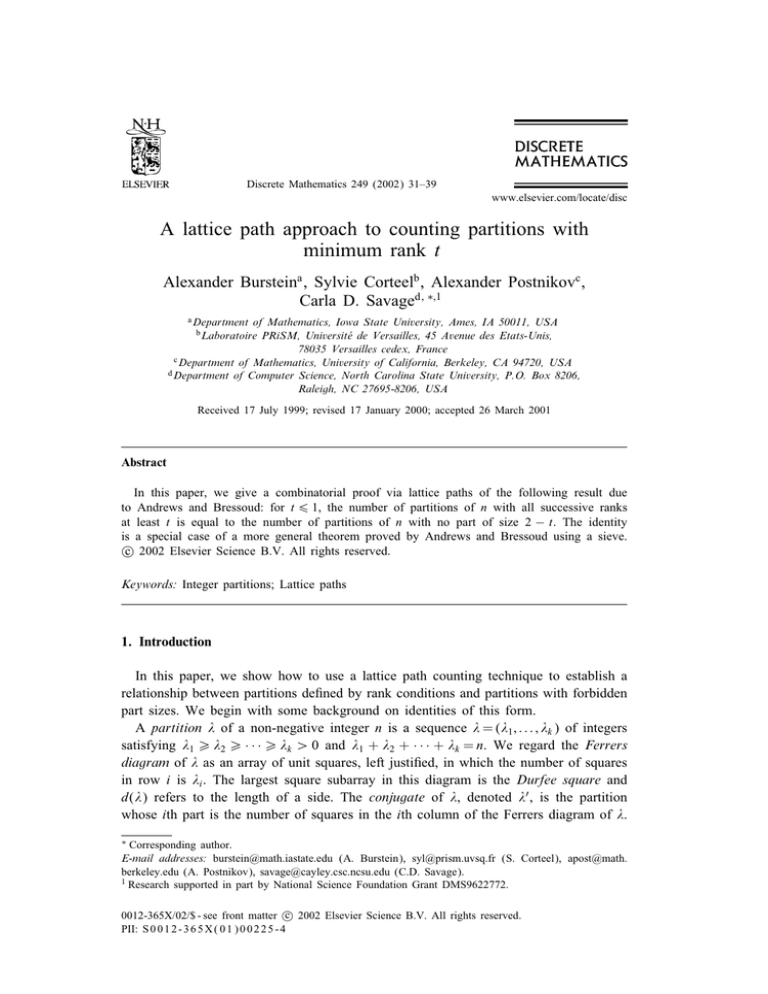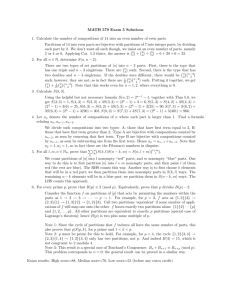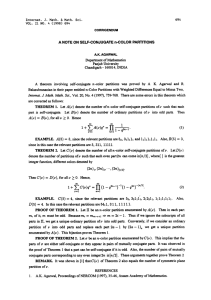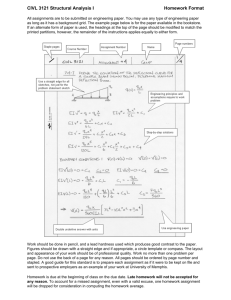A lattice path approach to countingpartitions with minimum rank t Alexander Burstein
advertisement

Discrete Mathematics 249 (2002) 31–39
www.elsevier.com/locate/disc
A lattice path approach to counting partitions with
minimum rank t
Alexander Bursteina , Sylvie Corteelb , Alexander Postnikovc ,
Carla D. Savaged; ∗;1
a Department
of Mathematics, Iowa State University, Ames, IA 50011, USA
PRiSM, Universite de Versailles, 45 Avenue des Etats-Unis,
78035 Versailles cedex, France
c Department of Mathematics, University of California, Berkeley, CA 94720, USA
d Department of Computer Science, North Carolina State University, P.O. Box 8206,
Raleigh, NC 27695-8206, USA
b Laboratoire
Received 17 July 1999; revised 17 January 2000; accepted 26 March 2001
Abstract
In this paper, we give a combinatorial proof via lattice paths of the following result due
to Andrews and Bressoud: for t 6 1, the number of partitions of n with all successive ranks
at least t is equal to the number of partitions of n with no part of size 2 − t. The identity
is a special case of a more general theorem proved by Andrews and Bressoud using a sieve.
c 2002 Elsevier Science B.V. All rights reserved.
Keywords: Integer partitions; Lattice paths
1. Introduction
In this paper, we show how to use a lattice path counting technique to establish a
relationship between partitions de8ned by rank conditions and partitions with forbidden
part sizes. We begin with some background on identities of this form.
A partition of a non-negative integer n is a sequence = (1 ; : : : ; k ) of integers
satisfying 1 ¿ 2 ¿ · · · ¿ k ¿ 0 and 1 + 2 + · · · + k = n. We regard the Ferrers
diagram of as an array of unit squares, left justi8ed, in which the number of squares
in row i is i . The largest square subarray in this diagram is the Durfee square and
d() refers to the length of a side. The conjugate of , denoted , is the partition
whose ith part is the number of squares in the ith column of the Ferrers diagram of .
∗
Corresponding author.
E-mail addresses: burstein@math.iastate.edu (A. Burstein), syl@prism.uvsq.fr (S. Corteel), apost@math.
berkeley.edu (A. Postnikov), savage@cayley.csc.ncsu.edu (C.D. Savage).
1 Research supported in part by National Science Foundation Grant DMS9622772.
c 2002 Elsevier Science B.V. All rights reserved.
0012-365X/02/$ - see front matter PII: S 0 0 1 2 - 3 6 5 X ( 0 1 ) 0 0 2 2 5 - 4
32
A. Burstein et al. / Discrete Mathematics 249 (2002) 31–39
The successive ranks of are the entries of the sequence (1 − 1 ; : : : ; d − d ), where
d = d() [1,7].
In [2] Andrews proved Theorem 1 below, showing a relationship between partitions
de8ned by a constraint on the successive ranks and partitions de8ned by a congruence condition on the parts. Theorem 1 is a signi8cant generalization of the Rogers–
Ramanujan identities [12] which can be interpreted in this framework. Andrews’ original result was for odd moduli M , but Bressoud proved in [3] that the result holds for
even moduli as well.
Theorem 1. For integers M; r; satisfying 0 ¡ r ¡ M=2; the number of partitions of n
whose successive ranks lie in the interval [ − r + 2; M − r − 2] is equal to the number
of partitions of n with no part congruent to 0; r; or −r modulo M .
Andrews used a sieve technique to prove Theorem 1. No bijective proof is known.
For the special case of the Rogers–Ramanujan identities ((r; M ) = (1; 5) and (r; M )
= (2; 5)) Garsia and Milne used their involution principle to produce a bijection [9],
which, though far from simple, was the 8rst bijective proof of these identities.
Recently, Theorem 1 attracted the attention of the graph theory community when
ErdHos and Richmond made use of it to establish a lower bound on the number of
graphical partitions of an integer n [8]. A partition is graphical if it is the degree
sequence of some simple graph. It was observed in [8] that the conjugate of a partition
with all successive ranks positive is always graphical and that setting r = 1 and M =
n + 2 in Theorem 1 gives:
Corollary 1. The number of partitions of n with all successive ranks positive is equal
to the number of partitions of n with no part ‘1’.
Rousseau and Ali felt that since Corollary 1 is such a special case of Theorem 1, it
should have a simple proof. In [13] they give a generating function proof which makes
use of a generating function of MacMahon for plane partitions and an identity due to
Cauchy. Venkatraman and Wilf, using a generating function for plane partitions due
to Bender and Knuth, with the help of q-Ekhad, veri8ed that Corollary 1 remains true
when the number of parts is 8xed [14]. In [6] a simple bijective proof of Corollary
1 was given, inspired by a result of Cheema and Gordon [5]. It turns out that a
(diLerent) bijection can be recovered from a result of Burge [4]. Setting M = n + r + 1
and r = 2−t in Theorem 1 gives the following generalization of Corollary 1. A bijective
proof appears in [6].
Corollary 2. For t 6 1; The number of partitions of n with all successive ranks at
least t is equal to the number of partitions of n with no part ‘2 − t’.
So, for example, the number of partitions of 7 with all successive ranks at least −1:
{(7); (6; 1); (5; 2); (5; 1; 1); (4; 3); (4; 2; 1); (4; 1; 1; 1); (3; 3; 1); (3; 2; 2); (3; 2; 1; 1)}
A. Burstein et al. / Discrete Mathematics 249 (2002) 31–39
33
Fig. 1. A north–east lattice path p and the associated partition (p) = (5; 5; 3; 1).
is the same as the number of partitions of 7 with no part 3:
{(7); (6; 1); (5; 2); (5; 1; 1); (4; 2; 1); (4; 1; 1; 1); (2; 2; 2; 1);
(2; 2; 1; 1; 1); (2; 1; 1; 1; 1; 1); (1; 1; 1; 1; 1; 1; 1)}:
In this paper, we show how to use a lattice path counting argument to give simple
proofs of Corollaries 1 and 2 and several generalizations (all previously known).
In Section 2, we state and prove the ‘lattice path identity’ and then derive its consequences in Section 3.
2. Lattice paths
For integers x1 6 x2 and y1 6 y2 , de8ne a north–east lattice path p[(x1 ; y1 ) →
(x2 ; y2 )] to be a path in the plane from (x1 ; y1 ) to (x2 ; y2 ) consisting of unit steps
north and east. The region enclosed by p and the lines x = x1 ; x2 , and y = y2 + 1 can
be regarded as the Ferrers diagram of a partition p (see Fig. 1). Let a(p ) denote
the area of this region. In this way, we get a bijection between north–east lattice
paths [(x1 ; y1 ) → (x2 ; y2 )] and partitions whose Ferrers diagram 8ts in an (x2 − x1 )
by (y2 − y1 + 1) box. Two lattice paths are called non-crossing if they have no point
in common. Let P(n; k) be the set of partitions of n with k parts and let P(n; k; l),
P(n; k; ¿ l), and P(n; k; 6 l) be, respectively, those partitions in P(n; k) with largest
part l, those with largest part greater than l, and those with largest part at most l. Let
R¿t (n; k) be the set of partitions in P(n; k) with all successive ranks at least t and
similarly for R¿t (n; k; l) and R¿t (n; k; ¿ l).
Theorem 2 (Lattice path identity). For t 6 1;
|R¿t (n; k)| = |P(n; k; ¿ k + t − 1)| − |P(n − 2 + t; k − 2 + t; ¿ k + 1)|:
(1)
34
A. Burstein et al. / Discrete Mathematics 249 (2002) 31–39
Fig. 2. For t = − 2, (a) partition with d = 5; k = 11; l = 9, and all ranks at least t and (b) the associated
lattice paths p and p .
Proof. Let be a partition in P(n; k; l) with Durfee square size d and de8ne partitions
and by = (1 − d; 2 − d; : : : ; d − d) (allowing entries to be 0 if necessary) and
= (d+1 ; d+2 ; : : : ; k ). Note that for t 6 1 and l − k ¿ t the lattice paths
p [(1 − t; 0) → (1 − t + l − d; d − 1)]
and
p [(0; 1) → (k − d; d)];
associated with and , are non-crossing if and only if i − i ¿ t for i = 1; : : : ; d,
that is, ∈ R¿t (m; k; l) (see Fig. 2).
Now, assume l − k ¿ t. (Otherwise, no partition in P(n; k; l) is in R¿t (n; k; l).) Then
to count the partitions in R¿t (n; k; l) with Durfee square size d we subtract from
|P(n; k; l)| the count of those partitions in P(n; k; l) with Durfee square size d whose
corresponding pairs (; ) give rise to a pair of crossing lattice paths. We count them
using the method of Gessel and Viennot [10,11].
Let p [(1 − t; 0) → (1 − t + l − d; d − 1)] and p [(0; 1) → (k − d; d)] be crossing
lattice paths associated with the pair (; ) corresponding to a partition ∈ P(n; k; l)
with Durfee square size d. We 8nd the 8rst point of intersection of these paths (moving
north–east) and exchange the parts of those paths before the 8rst intersection to obtain
a pair of paths q[(1 − t; 0) → (k − d; d)] and r[(0; 1) → (1 − t + l − d; d − 1)] (see
Fig. 3).
Let the partitions ˜ and ˜ be such that (;
˜ ˜ ) is the pair of partitions associated with
the lattice paths r and q, respectively. Then
a()
˜ + a()
˜ = a() + a() − (1 − t);
(2)
A. Burstein et al. / Discrete Mathematics 249 (2002) 31–39
35
Fig. 3. For t = − 2, (a) crossing paths corresponding to and (b) the paths after swapping, together with
˜
their corresponding .
since all the unit squares in both sums of the associated areas are counted with the
same multiplicities except for the area de8ned by 0 6 x 6 1 − t; d 6 y 6 d + 1. This
area is counted once by the right-hand sum of areas (as part of a()) and not counted
by the left-hand sum. Hence,
a()
˜ + a()
˜ = n − d2 − (1 − t):
Now, associate to the pair (;
˜ ˜ ) the partition ˜ obtained by taking a (d − 1) × (d + 1)
2
rectangle (of area d − 1) and adjoining ˜ to the east and ˜ (the conjugate of ˜ ) to
the south. Then ˜ has the largest part
(l − d) + (1 − t) + (d + 1) = l + 2 − t;
the total area of ˜ is
(d2 − 1) + (n − d2 − (1 − t)) = n − (2 − t);
36
A. Burstein et al. / Discrete Mathematics 249 (2002) 31–39
and the number of parts of ˜ is
((k − d) − (1 − t)) + (d − 1) = k − (2 − t):
So, ˜ is a partition in P(n − 2 + t; k − 2 + t; l + 2 − t) in which d is the largest integer
for which the Ferrers diagram of ˜ contains a (d − 1) × (d + 1) subarray. Conversely,
any such partition in P(n − 2 + t; k − 2 + t; l + 2 − t), by removing the partitions to the
east and south of the (d − 1) × (d + 1) rectangle, corresponds to a pair of lattice paths
[(1 − t; 0) → (k − d; d)] and [(0; 1) → (1 − t + l − d; d − 1)], which must necessarily
cross since, because l − k ¿ t,
1 − t + l − d ¿ 1 + k − d ¿ k − d:
Summing over all values of d gives, for t 6 1 and l − k ¿ t,
|R¿t (n; k; l)| = |P(n; k; l)| − |P(n − 2 + t; k − 2 + t; l + 2 − t)|:
Finally, summing over all l ¿ k + t gives exactly (1).
3. Consequences
Let R¿t (n) denote the set of partitions of n with all successive ranks at least t and,
as in the previous section, let R¿t (n; k) denote those with exactly k parts. Similarly,
let R=t (n) denote the set of partitions of n with minimum rank equal to t and R=t (n; k)
denote those with k parts. P(n) is the set of all partitions of n. Let Ps (n) denote the
set of partitions of n with no part ‘s’ and Ps (n; k) those with k parts. The partitions
of n which do contain a part ‘s’ are counted by |P(n − s)|. So, by splitting P(n) into
those partitions which do not contain a part ‘s’ and those which do, we get
|Ps (n)| = |P(n)| − |P(n − s)|:
(3)
If a partition in P(n; k) has no part ‘1’, we can decrease every part by 1 and still have
k parts, so
|P1 (n; k)| = |P(n − k; k)|:
(4)
For P(n; k; l), note that, by taking the conjugate,
|P(n; k; l)| = |P(n; l; k)|:
(5)
Also, by partitioning into those partitions which do have a part of size 1 and those
which do not,
|P(n; k; ¿ l)| = |P(n − 1; k − 1; ¿ l)| + |P(n − k; k; ¿ l − 1)|
(6)
|P(n; k; l)| = |P(n − 1; k − 1; l)| + |P(n − k; k; l − 1)|:
(7)
and
A. Burstein et al. / Discrete Mathematics 249 (2002) 31–39
37
Therefore, we can write for t ¡ 1, applying the lattice path identity (1) for the second
equality,
|R=t (n; k)| = |R¿t (n; k)| − |R¿t+1 (n; k)|
= |P(n; k; ¿ k + t − 1)| − |P(n; k; ¿ k + t)|
+|P(n + t − 1; k − 1 + t; ¿ k + 1)|
−|P(n + t − 2; k − 2 + t; ¿ k + 1)|:
The 8rst two terms on the right-hand side of the last equality give |P(n; k; k + t)| and
applying (6) to the last two terms gives
|R=t (n; k)| = |P(n; k; k + t)| + |P(n − k; k − 1 + t; ¿ k)|:
(8)
Theorem 3. |R¿1 (n; k)| = |P(n − k; k)| = |P1 (n; k)|:
Proof.
|R¿1 (n; k)| = |P(n; k; ¿k)| − |P(n − 1; k − 1; ¿k + 1)| (from (1))
= |P(n; k; k + 1)| + |P(n; k; ¿ k + 1)|
−|P(n − 1; k − 1; ¿ k + 1)|
= |P(n; k; k + 1)| + |P(n − k; k; ¿ k)|
(applying (6) to second
two terms)
= |P(n; k + 1; k)| + |P(n − k; k; ¿ k)|
(from (5))
= |P(n − k; k; 6 k)| + |P(n − k; k; ¿k)|
(removingk in 8rst term)
= |P(n − k; k)|:
The last equality in the theorem follows from (4).
We can now prove the 8rst corollary of the Andrews–Bressoud theorem.
Proof of Corollary 1. From Theorem 3, summing over k, and from (3) we get
|R¿1 (n)| = |P1 (n)| = |P(n)| − |P(n − 1)|:
We can also use the lattice path identity to prove the following four lemmas from
[6] and the second corollary of the Andrews–Bressoud theorem.
Lemma 1. For t ¡ 0; |R=t (n; k)| = |R=t+1 (n − 1; k − 1)|:
38
A. Burstein et al. / Discrete Mathematics 249 (2002) 31–39
Proof. From (8),
|R=t (n; k)| = |P(n; k; k + t)| + |P(n − k; k − 1 + t; ¿ k)|:
Thus, for t ¡ 0,
|R=t+1 (n − 1; k − 1)| = |P(n − 1; k − 1; k + t)| + |P(n − k; k − 1 + t; ¿ k − 1)|:
Use (7) on the 8rst term of the right-hand side and split the second term into those
that do and do not have largest part k to get
|R=t+1 (n − 1; k − 1)| = |P(n; k; k + t)| − |P(n − k; k; k + t − 1)|
+|P(n − k; k − 1 + t; k)| + |P(n − k; k − 1 + t; ¿ k)|
= |P(n; k; k + t)| − |P(n − k; k − 1 + t; k)| from (5)
+|P(n − k; k − 1 + t; k)| + |P(n − k; k − 1 + t; ¿ k)|
= |P(n; k; k + t)| + |P(n − k; k − 1 + t; ¿ k)|
= |R=t (n; k)|:
Lemma 2. |R=0 (n; k)| = |R¿1 (n − 1; k − 1)|:
Proof. From (8),
|R=0 (n; k)| = |P(n; k; k)| + |P(n − k; k − 1; ¿ k)|
= |P(n − k; k − 1; 6 k)| + |P(n − k; k − 1; ¿ k)|
= |P(n − k; k − 1)|
= |R¿1 (n − 1; k − 1)| from Theorem 1:
Lemma 3. For t ¡ 1; |R=t (n; k)| = |R¿1 (n − 1 + t; k − 1 + t)| = |P(n − k; k − 1 + t)|:
Proof. Repeated application of Lemma 1, followed by application of Lemma 2 gives
the 8rst equality. The second follows from Theorem 3.
Summing over k in Lemma 3 gives the following.
Lemma 4. For t 6 0; |R=t (n)| = |R¿1 (n − 1 + t)|.
A. Burstein et al. / Discrete Mathematics 249 (2002) 31–39
39
Proof of Corollary 2. (|R¿t (n)| = |P2−t (n)|).
0
|R¿t (n)| =
|R=j (n)| + |R¿1 (n)|
j=t
=
1
|R¿1 (n − 1 + j)|
by Lemma 4
|P1 (n − 1 + j)|
by Corollary 1
j=t
=
1
j=t
=
1
|(P(n − 1 + j)| − |P(n − 2 + j)|) by (3)
j=t
= |P(n)| − |P(n − 2 + t)|
= |P2−t (n)|
by (3):
References
[1] G.E. Andrews, Sieves for theorems of Euler, Ramanujan and Rogers, In: Theory of Arithmetic Functions,
Lectures Notes in Mathematics, Vol. 251, Springer, Berlin, 1971, pp. 1–20.
[2] A.O.L. Atkin, A note on ranks and conjugacy of partitions, Quart. J. Math. Oxford Ser. 17 (1966)
335–338.
[3] D. Bressoud, Extension of the partition sieve, J. Number Theory 12 (1980) 87–100.
[4] W.H. Burge, A correspondence between partitions related to generalizations of the Rogers–Ramanujan
identities, Discrete Math. 34 (1981) 9–15.
[5] M.S. Cheema, B. Gordon, Some remarks on two- and three-line partitions, Duke Math. J. 31 (1964)
267–273.
[6] S. Corteel, C. Savage, R. Venkatraman, A bijection for partitions with all ranks at least t, J. Combin.
Theory Ser. A 83 (2) (1998) 202–220.
[7] F.J. Dyson, Some guesses in the theory of partitions, Eureka (Cambridge) 8 (1944) 10–15.
[8] P. ErdHos, L.B. Richmond, On graphical partitions, Combinatorica 13 (1993) 57–63.
[9] A.M. Garsia, S.C. Milne, A Rogers–Ramanujan bijection, J. Combin. Theory Ser. A 31 (3) (1981)
289–339.
[10] I. Gessel, G. Viennot, Binomial determinants, paths, and hook length formulae, Adv. in Math. 58 (3)
(1985) 300–321.
[11] I. Gessel, X.G. Viennot, Determinants, paths and plane partitions, preprint, 1989.
[12] L.J. Rogers, Second memoir on the expansion of certain in8nite products, Proc. London Math. Soc. 25
(1894) 318–343.
[13] C.C. Rousseau, F. Ali, A note on graphical partitions, J. Combin. Theory Ser. A 64 (1995) 314–318.
[14] R. Venkatraman, Counting families of partitions de8ned by rank, M.S. Thesis, Department of Computer
Science, North Carolina State University, December 1996.








